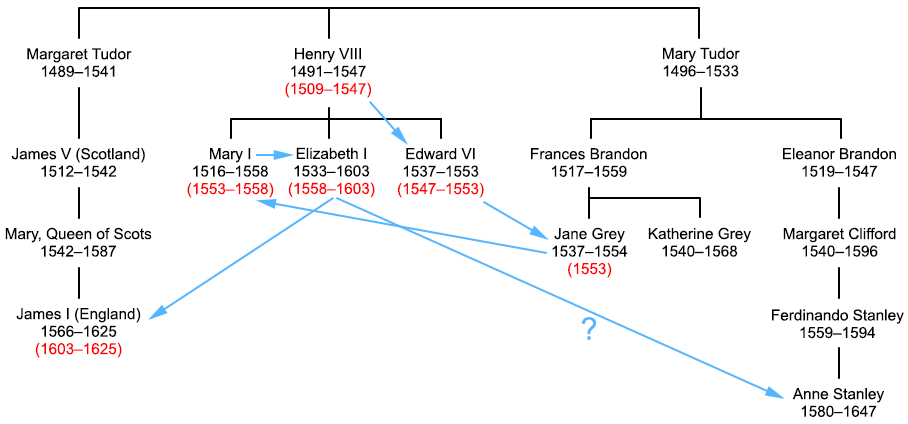

| Archive Blog Cast Forum RSS Books! Poll Results About Search Fan Art Podcast More Stuff Random |
|
Classic comic reruns every day
|
1 Mercutio: So how did Mary and then Elizabeth become Queen if Henry VIII illegitimised them?
2 Shakespeare: The Third Succession Act of 1543 restored them to the succession. The Acts also gave Henry the power to name his successors in his will, which he did.
3 Shakespeare: He reaffirmed their succession status following his son, Edward VI.
4 Mercutio: That’s a lot of successing going on.
4 Shakespeare: Yes, if only he’d succeeded.
|
First (1) | Previous (4758) | Next (4760) || Latest Rerun (2895) |
Latest New (5380) First 5 | Previous 5 | Next 5 | Latest 5 Shakespeare theme: First | Previous | Next | Latest || First 5 | Previous 5 | Next 5 | Latest 5 This strip's permanent URL: https://www.irregularwebcomic.net/4759.html
Annotations off: turn on
Annotations on: turn off
|
I kind of anticipated this strip with the annotation to strip #4748.
But picking up the story with Queen Elizabeth I:
The line of royal succession following Elizabeth was not clear, and remained uncertain throughout her reign. She never married and is conventionally assumed never to had any children. Similarly to Henry VIII and Edward VI before her, she had some power to nominate her own successors, but she declined to do so. Historians consider it likely that she feared that once she named a successor her own life would be in danger, from whoever it was trying to... accelerate the process of becoming the next monarch.
Henry's will had stated that if none of his children produced heirs—and neither Edward VI, Mary I, nor Elizabeth I had children—then the Crown should bypass the line of his eldest sister Margaret Tudor in favour of descendants of his younger sister Mary Tudor. The reason for this was that Margaret had married James IV of Scotland, and thus had given birth to the heir of the Scottish throne, James V. Being both Catholic and Scottish, Henry considered her descendants traitorous and unworthy of inheriting the throne.
Mary Tudor was the grandmother of Lady Jane Grey, who we met in the previous annotation. Henry's will is why Lady Jane was briefly considered by some to be the Queen of England after Edward VI's death, before she was ousted after 9 days in favour of Mary I.
But after Henry's own descendants ran out with the deaths of Mary I and Elizabeth I, the succession was open to some question again. If we follow Henry's wishes, the next in line to the throne would have been the 22-year-old Anne Stanley, later Countess of Castlehaven, a great-great-granddaughter of Mary Tudor, and cousin-twice-removed of Lady Jane Grey. For some time her father, Ferdinando Stanley, the 5th Earl of Derby, had been considered the likely successor of Elizabeth (after his mother Margaret Clifford), but he predeceased Elizabeth (and his own mother) in 1594. This left two women (Margaret Clifford and her granddaughter Anne Stanley) as the next successors of Elizabeth, which meant potentially well over 100 years of queens with no kings. 16th century England not being particularly known for equal opportunity, the tide of opinion began to turn to putting a male back on the throne, and attention turned to Margaret Tudor's Scottish descendants.
The family tree is as follows, with the succession marked with blue arrows:

James V and his daughter Mary, Queen of Scots, were Catholic, but her son James VI had been brought up Protestant, which removed one of the major objections to having him on the throne of England. So after the Earl of Derby's death in 1594, a polite and highly secret correspondence was set up between James VI and the English Parliament, exploring the possibility that James could be granted the throne of England following the death of Elizabeth I. With some years to complete the negotiations, an agreement was reached, and when Elizabeth finally died in 1603, James VI was declared King James I of England, uniting the Crowns of the two countries. Anne Stanley never got a say, and she made no protest, choosing not to put forward her claim to the throne.
And so began the reign of the House of Stuart, which ruled England until the death of Queen Anne in 1714.
Interestingly, if you trace the lineage of Anne Stanley, assuming that she was in fact the legal Queen of England following the death of Elizabeth, you conclude that the current monarch of England would be Lady Caroline Child Villiers, the only child of the first marriage of George Child Villiers, 9th Earl of Jersey. And Lady Caroline doesn't even have a Wikipedia page.
|
LEGO® is a registered trademark of the LEGO Group of companies,
which does not sponsor, authorise, or endorse this site. This material is presented in accordance with the LEGO® Fair Play Guidelines. |